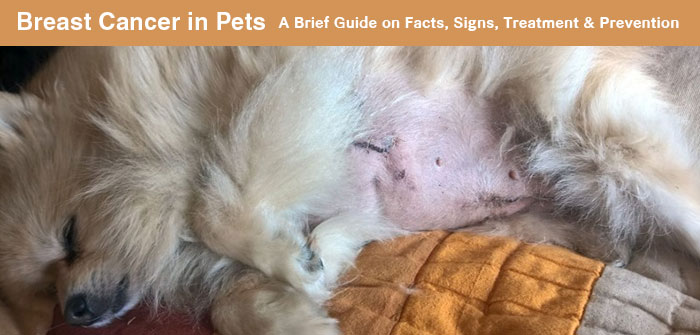Breast Cancer in Pets: A Brief Guide on Facts, Signs, Treatment & Prevention
New age has not only presented us with better lifestyle and luxuries, but also has left us with a plethora of dangerous and incurable diseases. With the whole world under its influence, pets are no exceptions, facing equally the risk of dangerous diseases. And, one such disease that has not even spared animals is cancer.
Cancer affects various organs of the body and therefore they are named accordingly. Whether it is blood cancer, breast cancer, bone cancer or ovary cancer all are equally fatal with no mercy on your furry pal.
Let’s learn more about the most common cancer – breast cancer in pets. Being aware of and gaining information about the signs and symptoms along with the treatment and prevention measures, as a pet parent you can ensure that your pet is well protected.
With advanced medical technology, today pets stand better chance of being successfully treated. And, the proper prevention program adds years to your pet’s life.
Important Facts You Should Know About Breast Cancer
- Breast cancer – it is an uncontrolled growth of abnormal mammary gland cells.
- Presently, compared to dogs, cats are more likely to fall the victim of breast cancer.
- Female pets, those have not been spayed, are more prone to the risk of this malignant tumour.
- Though the cause of breast cancer is unknown, researchers claim that hormones play a prominent role in causing this disease.
- Most, approx. 80 to 90 per cent, mammary tumours in cats are malignant, while 50 per cent of mammary masses in dogs are malignant.
- The major symptoms of breast cancer include firm nodules in the tissue around the nipples, ulcerated skin, and swollen, inflamed nipples with or without discharge.
- A surgical biopsy is the ultimate method used to figure out breast cancer.
- To find whether the cancerous cells have been spread to the other parts of the body or not, blood work and X-rays are usually recommended.
- For treating these tumours, invasive surgical treatment is provided along with the possibly radiation therapy and chemotherapy.
- Usually, vets recommend spaying female pets before they get heat cycle in order to prevent breast cancer.
Signs of Breast Cancer
Simple Signs That Every Pet Owner Should Be Well Acquainted With:
- Lump in the mammary area
- Nodular masses felt under the skin
- Tumours found in single mammary gland (the area around the nipple)
- Skin covering the tumour is usually infected or ulcerated
- Swollen and red nipples
- Discharge from nipples
There is no way to find if a lump is cancerous by feeling it. It is only through diagnosis, the actual nature of the lump is figured out. However, any lump in mammary gland has the potential to be cancerous, it is best to go for a diagnosis.
Treatment – Why It Is Important?
The best treatment for the cancerous tumour is the surgical removal of the masses. Your vet would recommend for blood work and X-Ray before performing the surgery. This aids in scaling out any possibility of malignant tumour in other part of the body specially enlarged lymph nodes. This provides proper insight in carrying out the treatment. In case of no evidences of nodes present elsewhere, the pet has proper flow of treatment.
Usually in cats, the cancer mostly attacks several mammary glands along the same side of the body therefore vets mainly recommend the removal of all the mammary glands on the same side. Conversely, if the cat is suffering with masses on both the sides, the surgeries are usually performed separately with few weeks gap in between in order to provide time for healing and recovery while gaining back the strength.
Unlike cats, dogs normally may not require such tissue removal.
It is also normal for vets to recommend spaying your pet at the time of surgery, in case they still have ovaries and uterus.
Radiation therapy or chemotherapy is usually followed after the surgery. It is a norm for veterinary surgeons to carry out this procedure, after the removal of the tissues, to kill any potentially cancerous cells in a focused area.
Normally, chemotherapy relates to the systematic drug administration to treat cancerous cells that may have spread to the other parts of the body.
Prevention
As the old adage goes, Prevention is better than Cure, so it stands for cancer too. Spaying the pet before the first heat cycle, can significantly aid in the prevention of breast cancer. And, the best period is spaying the pet by 1 year of age, which predominantly reduces the risk of breast cancer. The pets that are spayed at the later stage are highly vulnerable to the dangers of breast cancer.
Whether it is cancer, heartworm, flea and tick or worms, pets need to be well protected against all these dangers through proper treatments. Proper care, healthy environment and lot of love and care can definitely add value to their life. It is their frolic acts that fill our day relieving us from the stress. So, why not take a step ahead to fill colours in their life while ensuring their overall health.


